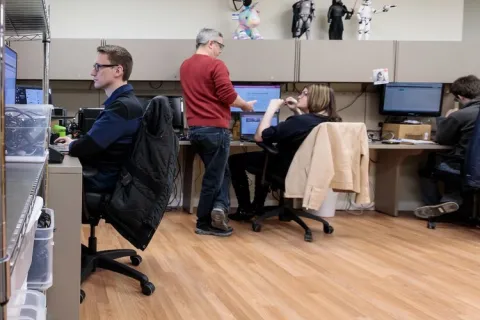Stimming to connect, relieve stress and cope with a pandemic
By By Anne NagelAnne Nagel is a cognitive engineer and human factors specialist at Autism Speaks. She is also an executive function coach with a focus on autistic girls and women.
For years, I hid my stims. I was taught as a child to be ashamed of my hand-flapping and rocking. As an adult, I started exploring why I stim. Now I’m teaching my children to stim. The mental health benefits to me of stimming are too great to ignore.
For me to understand my stimming — short for “self-stimulating behaviors,” usually repetitive movements or sounds — I had to recognize when I was doing it.
Growing up in the 1970s, the nuns at my Catholic grade school told me when I was stimming and to stop doing it. No one bothered to ask why kids stimmed back then. The reasons why are different for each person. Everyone stims, but those of us who are autistic often do it in a way that seems to be disruptive to others. As an adult, living with my autism means listening to my brain and recognizing its needs. My brain needs to stim.
I stim when my brain is stressed, overjoyed, deeply engaged or trying to fit into the world. When my kids see me pacing, they don’t comment on my movement. Instead they joke that my brain is zipping, and I can’t turn it off. In the mountains, you’ll see runaway truck lanes where trucks that get too much speed can detour to slow down. Stimming is often my brain’s runaway truck lane, where my brain goes when it is going too fast and needs to slow down.
I have different stims for different stresses. The key for me was identifying the stims for each stress. When I find my anxiety creeping up, I pace or move around my space. When I’m happy, I dance or flap my hands. When I’m trying to learn something new or working on a problem, I pace, sway, rock or fidget with my pencil. When I’m processing spoken language, I’ll doodle, wring my hands or jiggle my foot. When I need to understand my place in the natural world, I twirl. I love to twirl. When I’m bored, I play with my hair or pick at my skin. Boredom is something I try to avoid because the stim can be harmful. Just observing the wind in the trees or thinking about my special interest allows me to escape my mental boredom.
When COVID-19 hit, I found myself biting my fingernails again. I had stopped this stim years ago. It only returns when I’m deeply nervous – and my hands became a clue to my mental health. The last time I chewed my fingernails was after my mother’s unexpected death. Looking at my fingers one day, I realized I needed to take care of my mental health to help keep my hands out of my mouth – a dangerous stim during a global pandemic.
Some stims are unhealthy or offensive and need to be redirected. Many stims don’t offend other people but do make them uncomfortable. I don’t worry about those stims. Sometimes, I can convert my stim into a different movement that people find more acceptable. Instead of hand flapping when I’m excited, I use a dance move - raising the roof. As a 50-year-old woman, my kids cringe when I raise the roof. Even I recognize how silly it looks. But when I raise the roof joyfully, people notice the joy and not the movement. If I flap my hands while releasing a deep breath, people see a relaxation technique. To my brain, it’s all the same. It might be a more conscious choice of how I express things now, and that comes with maturity.
I find the mental health benefit of releasing my emotions and energy so beneficial I encourage non-autistic people to stim. Our children are facing a horribly stressful world, and any tools to deal with the stress will be useful. One evening, my daughter and I found ourselves in an open area at the local Target store. The Christmas merchandise had been moved out and the spring gardening and Easter products weren’t on display yet. Without even thinking, I stretched my arms out wide, turned my face up and slowly twirled a couple of times. At that moment I felt fully connected with the world. People spend hours in yoga classes and study mediation to get the peace that my brain finds naturally when I twirl. This evening, I invited my daughter to try twirling. I directed her to try it going right then left. Which direction did her brain like better? How did her brain feel after twirling? She admitted it was relaxing. It calmed her. This activity started a whole discussion on physical movements that can calm the brain.
Inviting my non-autistic friends to discover what stims they already use bridges the gap between the autistic and non-autistic worlds.
Once people realize the power of stimming, they often start to do it themselves and can find benefits from the emotional outlet it provides.









